MOSAIC OF
HERITAGE
Guide to the Cultural Heritage
of the Rijeka Ring

Welcome to Rijeka, the European capital of culture 2020, a unique city at the crossroads of Central Europe, the Mediterranean, and the Balkans.
Although it has existed since ancient Illyrian and Roman times, the development of Rijeka as we know it today began just over 300 years ago with the establishment of a free port, maritime activities, and industry. The freedom of this cosmopolitan maritime city continues to define its identity: an open, multicultural place where people and ideas gladly come ashore and thrive.
All these historical characteristics have created a dense fabric of the city’s physical appearance – a curious blend of Mediterranean, Austrian, Hungarian, interwar Italian, and modernist Yugoslav communist architecture, all squeezed onto a narrow, densely populated coastal slope.
If, during your stroll, you think the city resembles a mix of mismatched LEGO sets, don’t worry – you’re not the first to think so!
THE CURIOUS RIJEKA
Fiume Fantastika, as named in the iconic exhibition of the European capital of culture project – is beautifully ugly, an urban setting whose intensity has inspired pioneering movements such as the first clubbing scenes, punk, hip-hop, and techno in this part of Europe.
The city draws its energy from a mix of nations and languages, thriving on its borderline status and a lack of a clear identity – or rather, an excess of diverse identities forming a mosaic.
Once an industrial hub, Rijeka is now the centre of a lively urban agglomeration of 200,000 inhabitants, a unique blend of hyper-urban and hyper-rural territories stretching from dense high-rise blocks to picturesque towns, secluded coves, and snowy peaks – all within a 30-minute drive.

Architectural, urbanistic, climatic, and natural diversity here borders on the impossible!
It is precisely this diversity that makes our bay a space of unique and recognisable lifestyles, fostering understanding and respect for differences. We look to the present and the future through education, openness to new experiences, and international connections in culture and tourism, all while proudly holding the title of the most liberal city in Croatia and the former Yugoslavia.
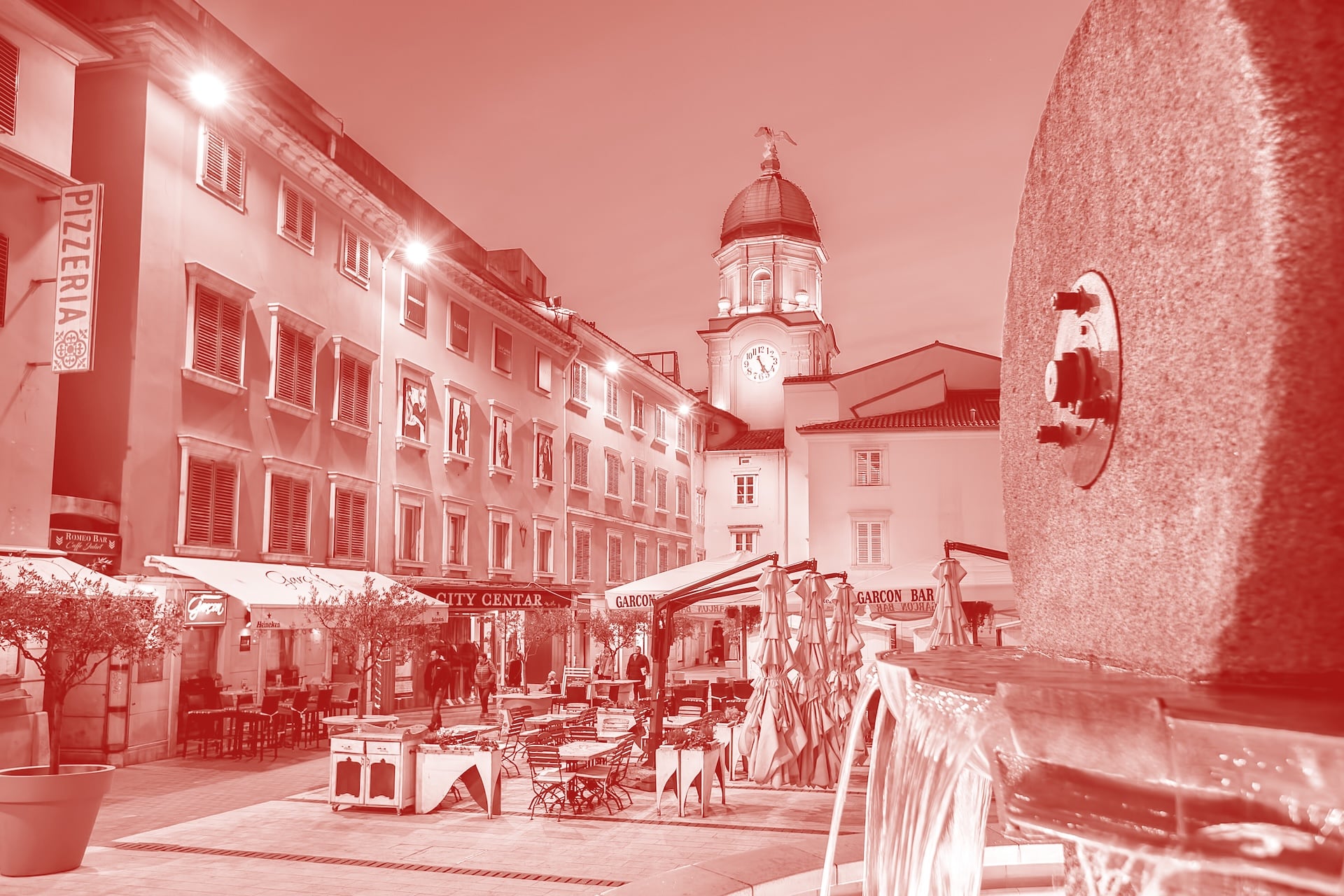
Rijeka is a city untouched by mass tourism. Here, tourists live side by side with locals – sharing the same bars, clubs, streets, and beaches.
We neither have nor want tourist ghettos; we are a city, not a destination, and our tourists are welcome temporary residents.
Enjoy it while you still can!
DEEP ROOTS
Modernity is easy to build on deep roots.
Rijeka’s modern character would be far less intriguing without the fascinating depths of its unique heritage, abundant in its immediate surroundings.
Where to begin?
The world has recognised two authentic local cultural phenomena by placing them on UNESCO’s prestigious World Heritage List.
The widely renowned zvončari are iconic masks and the hallmark of all local carnivals, especially the central and largest one – Rijeka’s carnival.
However, the true zvončari trails lie far from the city, on old shepherd paths and forest byways. Every year, in a time-honoured cycle, robust men adorned with fearsome animal-head masks, enormous heavy bells, and other distinctive details varying by village in the northwest outskirts, create a deafening cacophony to drive away winter and celebrate the arrival of warm, fertile spring.
Their story, along with ancient magical rituals, comes to life in the enchanting House of the Halubje Bell Ringers, an attractive cultural and social hub and the pride of the Rijeka region, including Viškovo, Kastav, Rukavac, Žejane, and other bell ringers villages.

Similarly rugged, raw, but powerfully authentic and primordial is the sound of the archaic folk music of the Rijeka region, performed in the so-called “Istrian scale”. Also protected by UNESCO, this polyphonic harmony cannot be replicated with “normal instruments” because it represents strictly local music incompatible with modern tonal scales and frequencies. This music is performed either vocally or using various wooden wind instruments, mostly handcrafted locally.
Its unique dissonance seems to evoke ancient emotions impossible to summon with conventional tones. Sometimes amusing, sometimes borderline unsettling, almost always shrill and piercing, it was a constant companion to all social rituals – celebrations, weddings, births, and funerals. Today, it is preserved as a unique global phenomenon, saved from the brink of oblivion.
The broader Rijeka region is the custodian of two significant documents of Croatian literacy and customary law. The Baška Tablet, dated around 1100, is the oldest written monument in the Croatian language, inscribed in Glagolitic script. It was discovered on the island of Krk in 1851.
On the mainland opposite Krk, in Vinodol, lies the home of the Vinodol Code, the oldest complete record of customary law in Croatian. Both Krk and Vinodol are closely linked to Rijeka’s urban region through one of Croatia’s most important noble families – the Frankopans.
While the western part of the Rijeka region belongs to the zvončari, the eastern part belongs to the Frankopans. These renowned nobles, indispensable to national history, left a rich legacy from the 12th to the 17th century as princes, bans, patrons, artists, and political revolutionaries in the fight for national emancipation.
A string of their fortified towns – from Grobnik, through Rijeka and Bakar, to the Frankopan harbour of Kraljevica and their castle, now the main visitor centre of the grand heritage project The Routes of the Frankopans – stands as a testament to their legacy.

TO SAIL IS A MUST
Rijeka is a city with a freshwater name and a salty, maritime character.
Born of the sea, it grew on its shores to become one of the largest ports in the region.
Its shores bear witness to countless ships that have sailed the world’s oceans, carrying the name of their city far from home. However, Rijeka is not merely a city by the sea; it is a city that lives with and from the sea.
Many generations have embraced its rhythm, understood its tides, and respectfully turned it into an ally in life. With its powerful port, Rijeka became the heart of maritime trade, shaping the identities of the surrounding towns and villages.
Bakar became home to a fishing community where nets and boats are not just tools but a way of life. Kraljevica became the guardian of shipbuilding tradition, crafting vessels that carry the pride and expertise of its master builders. Unique for its maritime and captaincy traditions, Kostrena became synonymous with maritime knowledge and world-renowned sailors.

Walking along the Rijeka Bay, you will encounter numerous monuments that tell ancient maritime stories. Among them are tunere, ancient systems for tuna fishing that intrigue passers-by – ladders climbing into the air at a 45-degree angle, ending above the sea.

Continue your walk along the “Routes of the Frankopans”, a cultural-tourist route that unveils diverse stories about the life and wealth of the powerful Frankopan family, covering 17 castles and three sacred sites in the region. The history of the Frankopans, princes of Krk, spanned over five centuries, during which they were the bearers of political, social, and cultural development in today’s Kvarner region. Their heritage is visible in castles, fortified towns, and palaces, which evoke the spirit of the past, intrigue, conflicts, and culture.
The Frankopans wove a network connecting Bakar, where they safeguarded the port’s security, Kraljevica, which they elevated into a shipbuilding centre, and Grobnik, where they monitored land routes. Each of these towns became a precious stone in the mosaic of their power, a silent witness to the trade networks and legacy they shaped over centuries. Amid old trade routes and steep cliffs, the Frankopans intertwined land and sea into one: each castle was like an island, each bay like a palace. Together, Kvarner and the Frankopans crafted a story of history, strength, and the enigmatic beauty of this region – a tale carried by time into legend.
If you visit the Kostrena seaman’s house, you will discover why the saying “To sail is a must” exists.
Sailing means living, as sailing in this region is indeed a way of life. This interpretive centre offers insights into the unpredictability of the sea and local themes about the challenges faced by sailors, past and present, through original artefacts and interactive multimedia presentations.
The life and spirit of sailors, their openness, resourcefulness, and resilience, reflect how they embraced the unknown, just as ships have always arrived with new faces, ideas, and challenges. The sea gave them the courage to explore but also the wisdom to return home.

For those who sought their fortune elsewhere in the world, the opening of the Hotel for Emigrants in 1908 was of great significance. The hotel, still standing today in Industrijska Street (a sort of monument to Rijeka’s industrial heritage), is now known as Milutin Barač Street. At the beginning of the street, you’ll find a “walking” lighthouse, which has been relocated three times throughout its history.
Further down the street, you’ll come across the Hotel, which once accommodated up to two thousand emigrants daily. During one of the regular emigrant line voyages between Rijeka and New York, the ship Carpathia received an SOS signal from the Titanic.
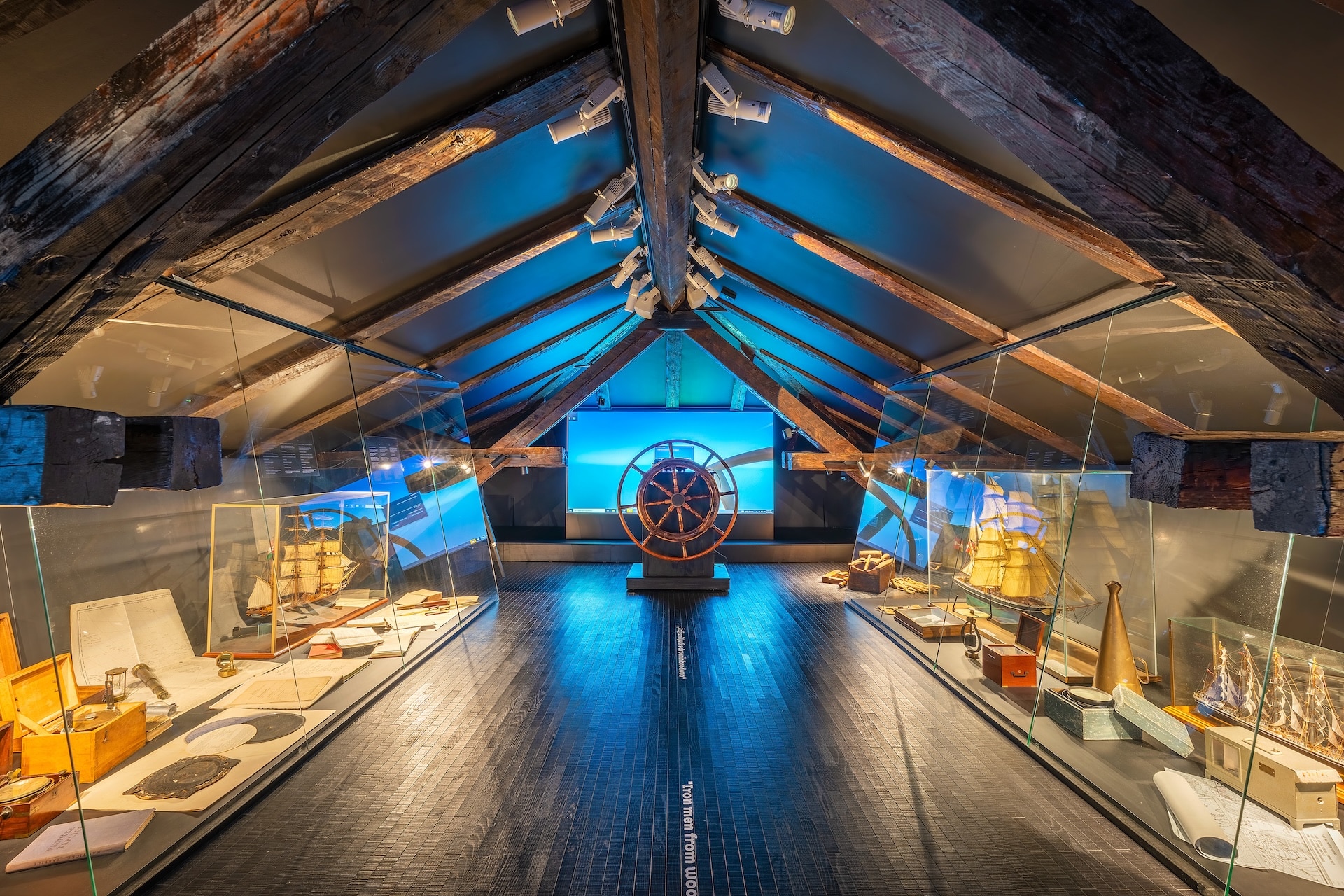
The crew responded urgently, arriving at the site of the tragedy and rescuing 706 survivors, whom they later transported to New York. Among them was a sailor from Rijeka who brought back a life jacket from that brave rescue mission. Today, this invaluable artefact can be seen at the Maritime and History Museum in Rijeka, serving as a permanent reminder of the city’s historical connection to one of the greatest maritime tragedies.
The Governor’s Palace, which houses the museum and overlooks the sea, was a kind of beacon of political power and influence.
. It was not just a residence for powerful figures but also a symbol of Rijeka’s strength as a significant maritime force, preserving the memory of the days when ships laden with goods from around the world docked at the city’s port.

The stories of Rijeka’s industrial and maritime heritage are not just salty; the oldest of them is also the sweetest, as you will learn in the magnificent Sugar Palace.
While it is often said that sugar comes last, in Rijeka’s industrial history, sugar was at the beginning – the sugar refinery was the city’s first and oldest industrial facility.
Once serving as an administrative building, barracks, tobacco factory, and engine factory, the palace is now a stunning museum that integrates Rijeka’s entire history. It reminds us of the many states Rijeka belonged to in the 20th century, the work of the Paper Mill, Oil Refinery, Chocolate Factory, and Rice Mill, Rijeka’s role as an emigrant port, events of World War II, the city’s theatrical and musical life, education, automobile culture, and everyday life.


And, of course, the invention of the torpedo. In 1866, in Rijeka, the first torpedo was invented based on Giovanni Luppis’s idea of a coastal defence boat, perfected and developed by English industrialist and investor Robert Whitehead.
This revolutionary invention brought Rijeka global renown, establishing it as a centre of great technological achievements in maritime, military industry, and global business.

CULTURAL INDUSTRY
A city once known for its factories, shipyards, and industrial strength is now undergoing a significant transition, transforming from a city with a rich industrial heritage into a cultural hub that honours its past while boldly looking towards the future.
After holding the title of European Capital of Culture in 2020, Rijeka has become a place where creativity and art take centre stage, replacing the chimneys and factory complexes that once defined its skyline.
One of the most powerful symbols of this transformation is the revitalisation of the Rikard Benčić district, a former industrial zone that is being converted into a modern cultural complex.
Located in the city centre, this complex traces its origins back to the 18th century when the largest imperial Sugar Refinery was established along this part of Rijeka’s coast.

Today, the area, popularly known as Art Quarter, has taken on a completely new role – that of the city’s living room. It now hosts institutions such as the aforementioned City Museum housed in the Sugar Palace, the Museum of Modern and Contemporary Art, the City Library, and the Children’s House – spaces that attract new generations of artists, creatives, and visitors.
The Exportdrvo hall, once the most modern warehouse for wood products passing through Rijeka’s port, has also been repurposed. When the hall was built in 1961, few could have imagined that sixty years later it would become one of Rijeka’s key cultural spaces. Instead of timber, it now hosts architects, artists, actors, and dancers, and audiences flock to enjoy a wide variety of creative events. Exportdrvo, as a symbol of change and renewal, continues to be a central part of Rijeka’s cultural and entertainment scene even after 2020.
These new spaces are not just symbols of spatial revitalisation but also represent a transformation in the city’s identity. This transition highlights Rijeka’s ability to adapt, transform, and continually reinvent itself, preserving its past while building its future.
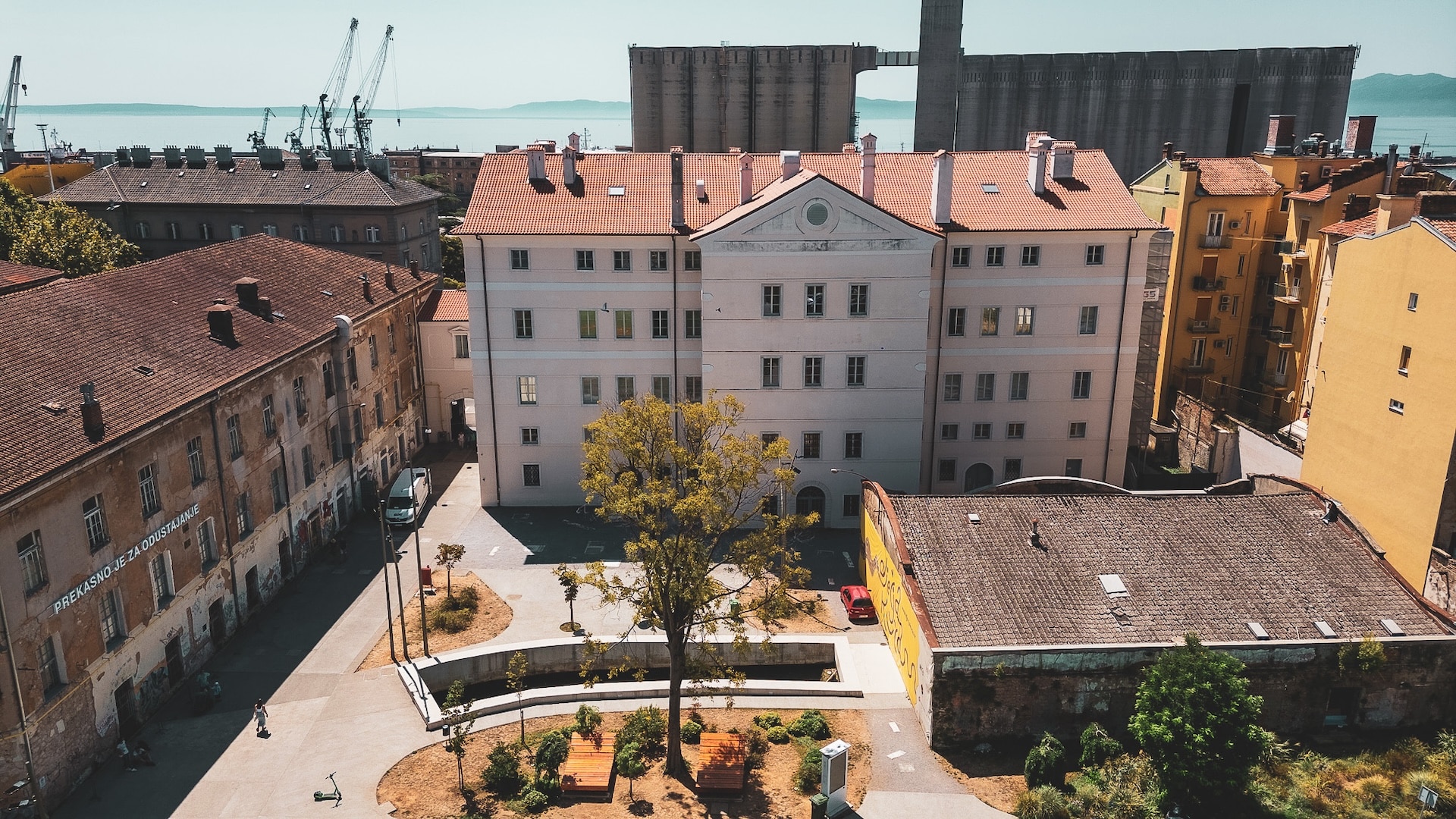
That future will soon include the Galeb, a famous ship that is being transformed into a museum-hotel. Originally built for transporting tropical fruit, the ship later survived being torpedoed, sinking, and spending three years at a depth of 22 metres. It eventually became the globally renowned floating residence of Josip Broz Tito and the Non-Aligned Movement.
Galeb’s deck hosted some of the greatest political leaders of the 20th century as well as numerous artists. Now, it is set to become an attractive museum featuring reconstructed original furnishings, as well as numerous original photographs and artefacts from global social and political history.
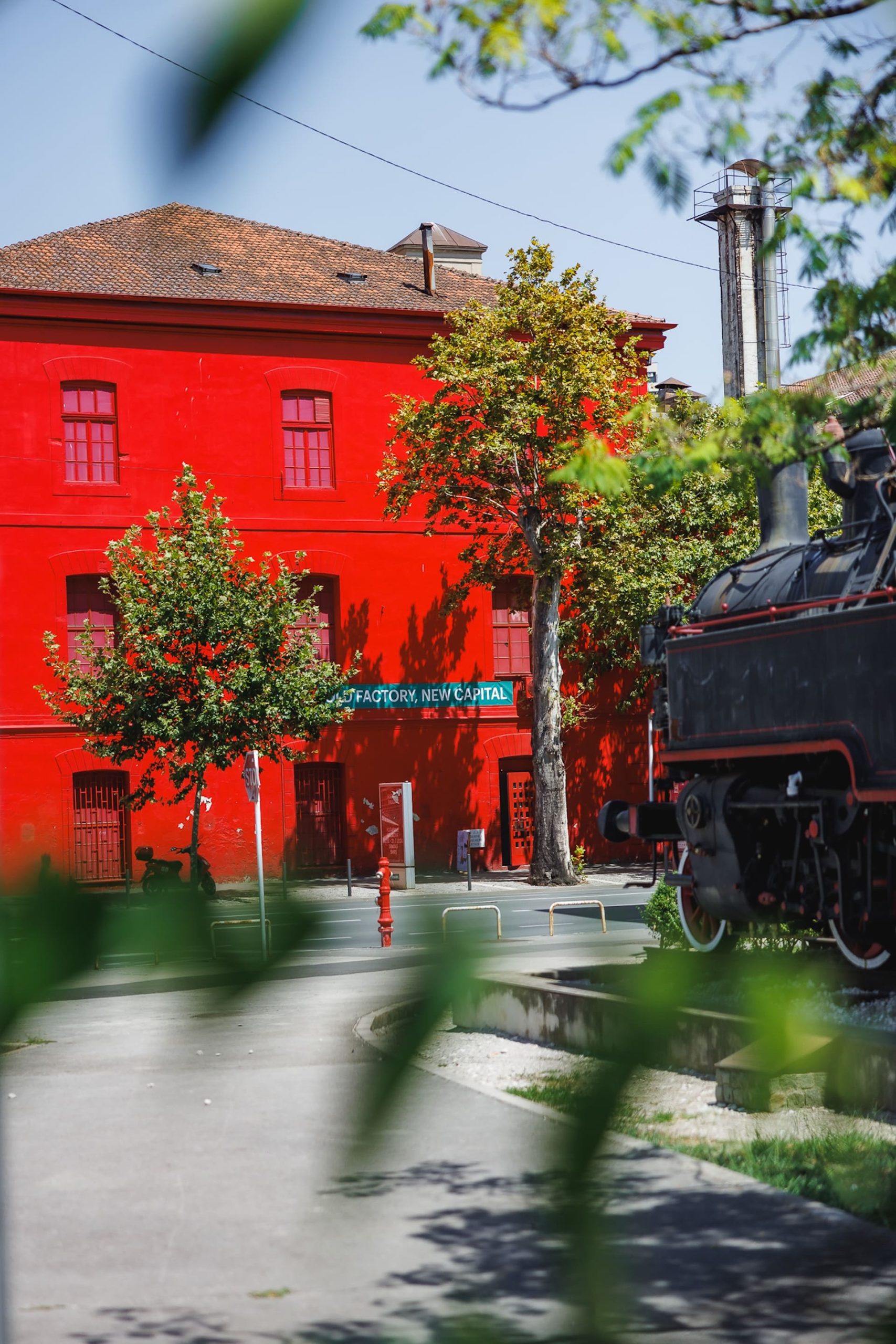

Among the living examples of cultural revival are two private, small yet equally significant museums – the Museum of Pharmacy and the fascinating Peek & Poke, now a cult Museum of Old Computers, a place where one can take a glimpse into the past of popular technology.
This unique museum offers innovative programmes that both visitors and prestigious global institutions adore and frequently celebrate. Peek&Poke, with its forest of exhibits, reminds us of how quickly technological futures become the past, as we almost imperceptibly transition from one digital age to the next, leaving behind innovations that were recently visions of tomorrow. Impossibly entertaining and educational!

Rijeka has always been a city that builds bridges between generations, traditions, and ways of life. In this ongoing cycle of change, the city stands as an example of how industrial heritage can be revitalised through art, innovation, and creativity, turning it into the centre of a modern cultural industry that shapes new horizons. Inexhaustible, as described on its city coat of arms, Rijeka is shaped by the countless currents and waves of change – true to its name.
It is no coincidence that one of the city’s most famous mottos is: “I love the city that flows.”

THE GLOBAL SOUND OF THE CITY
It’s hard to pinpoint exactly where Rijeka draws its sonic lifeblood.
Some say it’s because sailors brought the latest records from their travels around the world. Others claim that new songs arrived from Trieste via Italian radio and TV stations. And then there are those who attribute Rijeka’s musicality to its excellent music school and opera, which has thrived for three centuries in continuity.
All of these explanations are partly true.
Before shipping and maritime trade became the automated container industry we know today, Rijeka’s sailors and port functioned as the internet before the internet – trends always arrived here first.
The nearby border with the “soft Iron Curtain” in Trieste leaked fashion, sound, and lifestyle in all directions. No wonder Rijeka and its beautiful neighbouring coastal gem, Opatija, have always been places of free thought. Western trends collided here with the unique blend of a rich industrial working-class city and its adjacent haven of high tourism – Opatija – creating a vivid mix of music and popular culture, enriched by local folklore.

If you had wandered into this part of the world uninformed in the late 1970s or early 1980s, you might have thought you had accidentally landed in some undiscovered southern English colony where punk and new wave grew like wild, self-sown, yet strangely edible plants – in absurdly abundant quantities!
This was true of other musical and even fashion influences, as music sometimes served as just another fleeting trend.
Although it is rich in every conceivable musical genre, from turbo-folk to opera, Rijeka has always been renowned for its musical underground, with the hard sounds of punk, heavy metal, hip-hop, and techno. As a fundamentally working-class city, it seemed to embody the lyric of the famous Yugoslav new wave artist Vlada Divljan: “She works in a mine, her life isn’t easy; that’s why she doesn’t like music – she loves a strong rhythm!”
This strong rhythm, eccentricity, and provocativeness were on full display for all of Europe when the Rijeka-based band Let 3, pioneers of the city’s scene, performed at Eurovision 2023.
In Rijeka, look for clubs and bars with live music, iconic venues like the immortal rock club Palach, operating continuously since 1968, or visit the memorial to Husar, one of the first discotheques in Europe, which opened way back in 1957.

Just as that proto-discotheque found its home next to an old Masonic lodge, and jazz concerts are regularly held in a Baptist church, there is also a techno club named Crkva (Church), electronic music parties in abandoned military tunnels, retro rock gigs on a ship-hotel, and even occasional performances at the fish market!
These quirky details all point to one thing: music truly grows on every corner. You need to experience the Fête de la Musique in the gardens of the Governor’s Palace with young musicians from the music school, summer evenings at Kastav’s Crekvina, jazz improvisations on the beaches, or the traditional finale of Rijeka’s carnival – the euphoric, deafening clanging of the Halubaj Bell Ringers. Now that’s prehistoric heavy metal!
Of course, there’s no need to over-mystify fringe and underground phenomena, because, as everywhere, mainstream music dominates. While this text is being written, the youth are overwhelmingly drawn to the sounds of trap and various post-Yugoslav pop-folk hybrids – something that makes both parents and veteran rockers roll their eyes. But that’s okay – teenagers are meant to annoy their parents, and Rijeka exists so that music and every music lover can feel at home here in their own way!
Now forget everything you’ve read, because the wisest don’t think about music at all – they simply listen, play, and dance! And as for Rijeka being a musical city? There’s no need to overthink that either – it’s simply undeniable.
RIJEKA ARCHITECTURE TOURS
(ambience and architecture)
In Rijeka, opposites coexist harmoniously.
As you walk through the city, you’ll be amazed by how history and modernity, grandeur and intimacy, industry and nature intertwine, creating a unique ambience that makes the city vibrant and unpredictable. At every corner, square, and street, Rijeka tells a story that invites exploration, leaving you with the impression that a new discovery awaits behind every turn. Rijeka is truly a city of micro-locations.
Rijeka’s architecture, like the city itself, carries tales of past eras while reflecting constant change and adaptation. Over the centuries, different styles have interwoven in Rijeka, each leaving its mark on the city streets. Through its centuries-old buildings, palaces, and industrial complexes, Rijeka chronicles a history that testifies to its maritime, commercial, and industrial heritage.


Your adventure can begin with a stroll along the Dead Channel, the old Rječina riverbed, which still serves as a harbour for small boats.
Pause in front of the Hotel Continental, a place renowned as one of Rijeka’s most famous gathering spots, especially for the youth – a legendary meeting place, “Kont”.
This distinctive location, where a bridge-square once spanned the former state border (between Italy and the Kingdom of Yugoslavia during the interwar period), created a vibrant public space for everyone, shaping the living identity of the city.
Continue towards the unique urban canyon in the city centre – Vodovodna or Ružićeva Street, where Rijeka’s residents once worked in their powerful trades and factories. The facades of numerous buildings are now adorned with murals, featuring themes ranging from historical to abstract depictions. A girl blowing a sailing ship into the distance, a ship in a bottle, a facade dedicated to Rijeka’s bands, and many more.

These murals revitalise public spaces, adding colour to city streets and fostering a dialogue between architecture and contemporary art. Both streets lead you to another significant industrial area of Rijeka, the most prominent symbol of which is undoubtedly Hartera, the former paper factory. During the 19th and 20th centuries, Hartera was a driving force behind the city’s industrial development – a place where generations worked, created, socialised, and grew up. Pause to take in the building of the former factory power plant, or Energana – once the most modern facility with steam turbines and an 85-metre chimney. Today, it has been transformed into Sinergana, an incubator for creative technologies and the IT industry.
Leaving the factory complex, the path takes you deeper into the canyon along the banks of the Rječina River. Soon, an oasis of tranquillity opens up before you, with the picturesque ruins of two monumental giants: Žakalj Mill and Matešić Mill. Built in the 19th century, these mills were repeatedly damaged by floods and fires but were rebuilt until they were finally left to nature. In a place once dominated by industry, nature has reclaimed its space, weaving magic around the walls with unstoppable, living vegetation.

If you venture a little further from Rijeka towards Bakar, you’ll encounter the Bakarski prezidi – monuments to human effort and ingenuity. These manually built dry-stone walls were created to form terraced vineyards on steep slopes. Once, these terraces nurtured the famous vines used to produce a renowned sparkling wine. Today, the abandoned prezidi are being restored as symbols of perseverance and the craftsmanship of generations who shaped this extraordinary landscape with their hands.
No matter which direction you take, beautiful ambiences will greet you.
Whether you walk through the narrow stone streets of Kastav or Bakar, pass by the monumental walls of Trsat Castle, or explore the charm hidden in the industrial strength of Kraljevica and the greenery of Grobnik, every corner tells its own story. At every step, you’ll feel how history intertwines with the present – from old castles, churches, and fortifications to contemporary artistic interventions and revitalised industrial zones. Every path leads to new discoveries.
The only thing that matters is to start the journey.

THE RHYTHM OF LIFE
The best thing a tourist can do in Rijeka is to live like a local, feel the city, and explore it in their own authentic way. Be a guest, not a stranger!
So, how do Rijeka’s residents live?
To start, take a “Đir po Korzu”, a loop walk up and down the main promenade. See who’s around, meet someone, and soak in the city’s spirit. Aimless strolling along the main promenade is a cornerstone of the Mediterranean way of life. Korzo, for a relatively small city, is a long promenade stretching nearly 700 metres and offering a wealth of attractions: cafés, shopping, residential, commercial, and important public buildings. Unlike the centres of many Adriatic towns, Korzo maintains a vibrant local life 365 days a year.
From students to retirees, businesspeople to street performers, everyone comes here for something. Korzo remains the heart of Rijeka’s public and commercial life, its downtown and city centre. If you only have a few hours in Rijeka, spend them here – this is where life and people are. It’s enough for a first quick encounter with the city – a speed date with Rijeka.

If you have more time, venture further. Step into the port and walk to the end of the Molo Longo pier.
Rijeka stretches across a steep, elongated, narrow slope along the coast, like a 10-kilometre-long concrete serpent. The view from the nearly two-kilometre-long breakwater, the port’s protector, offers a full panorama of the city’s broader architectural landscape.
Nothing is hidden – every beautiful building and every architectural misstep is visible here, creating a small school of 18th, 19th, and 20th-century architecture. Palaces, silos, monstrous high-rises, gigantic cranes, eccentric places of worship, and small Mediterranean houses – all in a uniquely beautiful disarray!
With the entire port between your view and the city, there’s nowhere to hide the rough spaces of labour. It’s all present in one intense, claustrophobic vista that some love and others don’t, but no one remains indifferent.

Enough walking and port views – it’s time to eat, go back. If you’re lucky, you might witness the crazy freight train passing along the Riva, causing a traffic jam as it hauls hundreds of containers from one side of the port to the other.
It’s marenda time – a quick, inexpensive cooked meal during the workday break is typical for Rijeka locals. Pragmatic (and perhaps a little thrifty), they prefer daily marenda meals to less frequent but lavish restaurant dining. Adapt to the tradition – go for something local, like fish! To understand why, take a look at the sensational city fish market nearby, dubbed the “Cathedral of Fish” by the famous Monty Python member and global traveller Michael Palin. If fish isn’t your thing, there’s plenty of cuisine reflecting the mix of Mediterranean, Central European, Balkan, and global fusion influences.
Frequent, quick, affordable, fresh – this is the golden rule of marenda!
If it’s a summer afternoon, it’s time to “throw yourself into the sea”. Rijeka’s beaches are close by, mostly small, with pebbles, rocks (called grotte), and the occasional concrete platform. These are neighbourhood beaches where you still know who swims there, what time of year, and at what time of day. Even the beach bars strive to retain their regular local guests. Prices are shockingly normal, and events like concerts and cultural happenings are often under-promoted (can you imagine!) to preserve the delicate balance between locals and tourists. Visit Rijeka soon while these rare (non)tourist practices still exist!
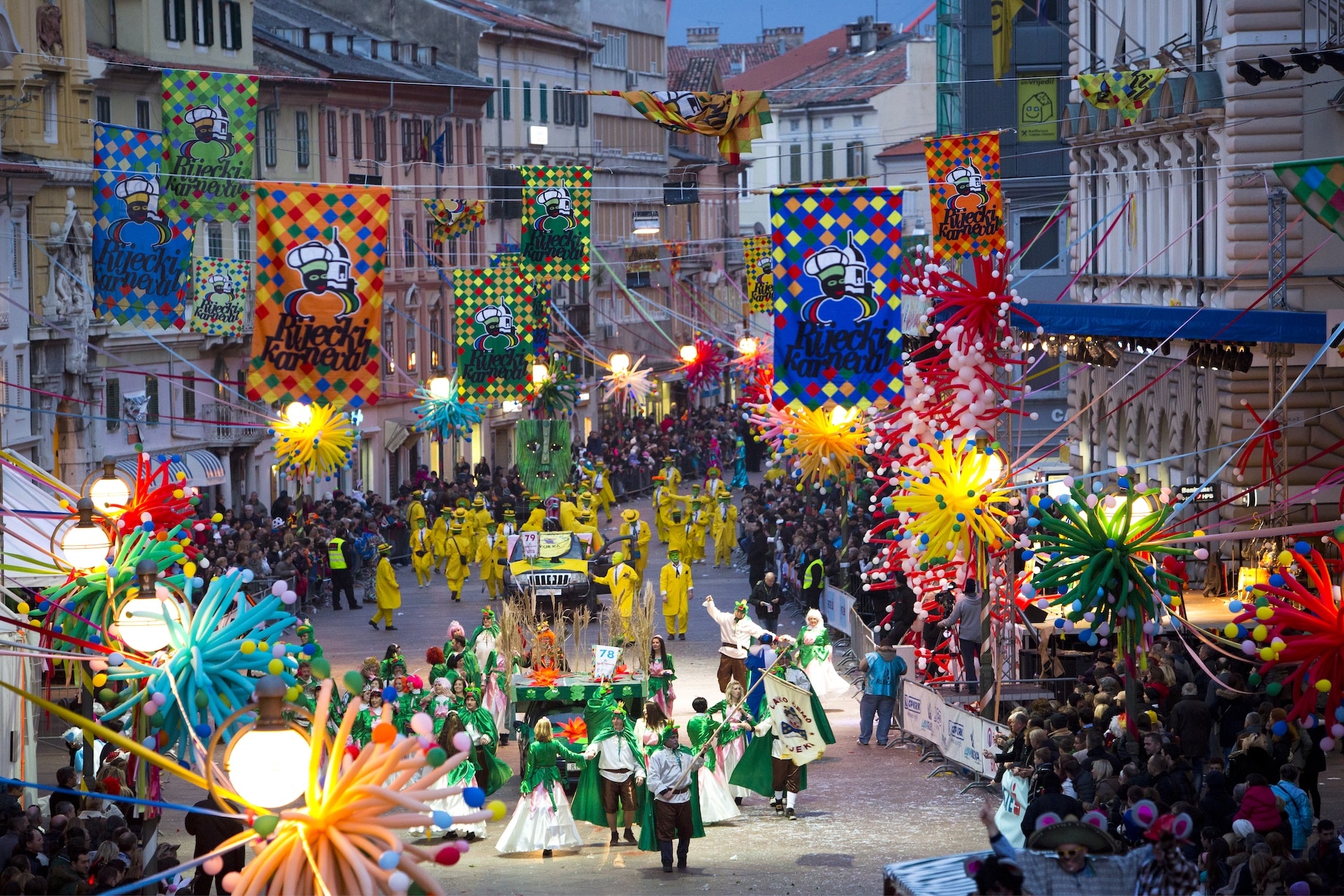
Winter also has its charm.
Pre-holiday Advent days, festive activities in the Art Quarter, and the peak of the opera and ballet season make Rijeka different from other coastal towns that often hibernate through the winter.
The climax of this season is undoubtedly the traditional Rijeka Carnival.
A pagan tradition cleverly intertwined with the Catholic calendar, it is a symbol of the city. These are the days when all the authentic traditional masks from the suburbs, of which the city is immensely proud, meet modern carnival interpretations. This friendly clash produces an extraordinary amount of good cheer, culminating in a grand carnival parade where 100,000 souls bid farewell to winter and celebrate the arrival of spring with enormous amounts of noise and a cacophony hard to compare to anything else. It’s fair to say it’s a wild mix of ethno music, rave parties, and operatic Mad Max scenography with strange, loud vehicles.
Irresistible!

When we tire of the city, we love to escape and enjoy the riches of the surrounding area.
There’s Kastav, with the soothing ambience of a classic “hilltop village” and its most famous traditional fair, the Bela nedeja celebration of young wine. A similar charm can be found in Grobnik, where proud locals preserve traditions, and their food reflects a history of humble rural life – cheese and the local speciality palenta kompirica.
The eastern coast leads to the home of sailors and ships – long, contemplative walks along the Kostrena coastline, proud Bakar, and the castles of Kraljevica offer a unique blend of natural landscapes, old city centres, and monumental industrial sites, ports, and shipyards – so typical of this coastline.
When we really want to get away, we escape even further – “jumping over to Trieste for coffee” is a favourite pastime of leisurely indulgence. The nearby beautiful Opatija also serves this purpose, though the proudest Rijeka locals will say: “The best thing about Opatija is the view of the other side of the bay – the view of Rijeka.”

So, let’s return to the city for its iconic view to complete the experience.
A city of hills, ascents, and stairs invites you to climb high – to peace and clarity at the city’s most famous ascent – the Trsat Stairs. With 539 steps (some say 561, and there’s a legend that they’re impossible to count), they lead to the beloved Church of Our Lady of Trsat, the Franciscan monastery, and the most beautiful view of the city and our Bay, which truly deserves a capital letter.
Looking at the city from the old castle, the same city where you’ve spent the day wandering and enjoying yourself. Wave to it from above and promise to return!
By now, you’re a little bit of a Rijeka local yourself.

